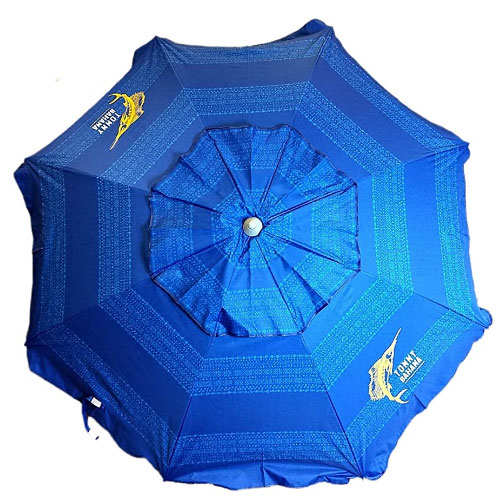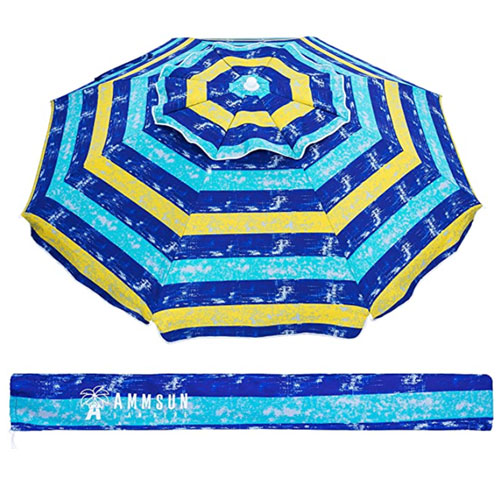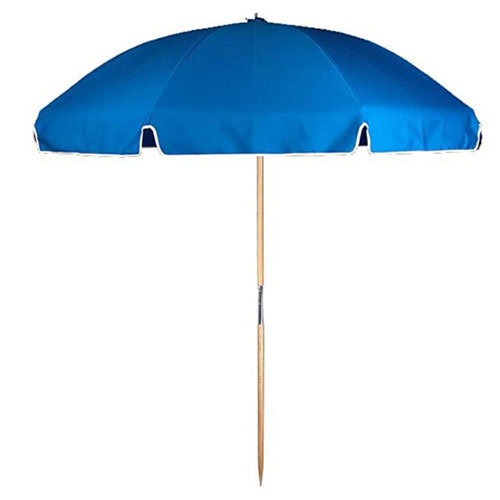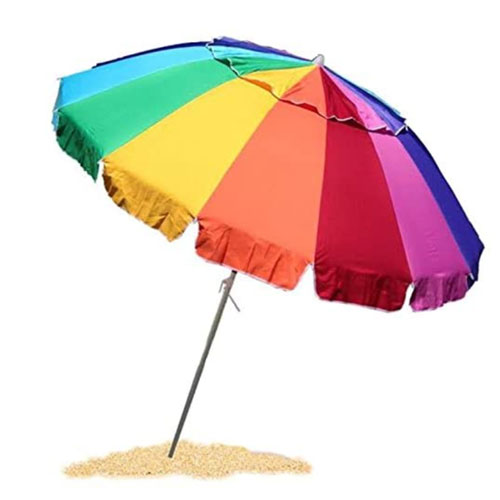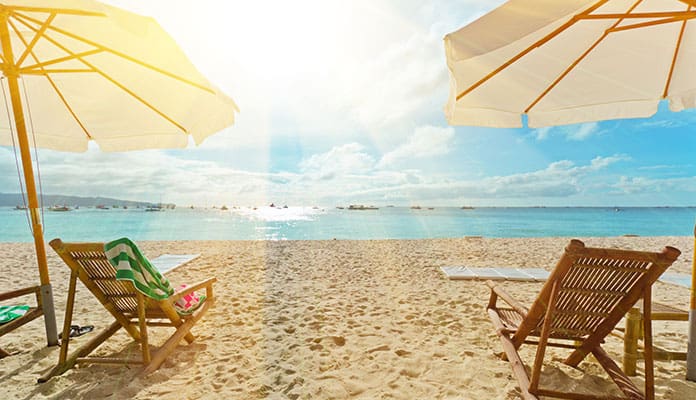
-
1.
-
2.
-
3.
-
4.
-
5.
If you’re looking for ultimate protection on sun-filled beach days, a good beach umbrella must have a place on your list. Not only does it block UV rays and prevent sunburn, but the best beach umbrella will also provide a generous shade where you can kick back and relax.
When choosing, it’s important to consider the size, material quality, and how easy the umbrella is to use. In addition, it should be lightweight and easy to carry. To help you find the perfect one, this article will discuss some of the best portable beach umbrellas available, guaranteed to make your day on the beach even better.
OUR TOP PICK
BeachBub All-In-One Beach Umbrella
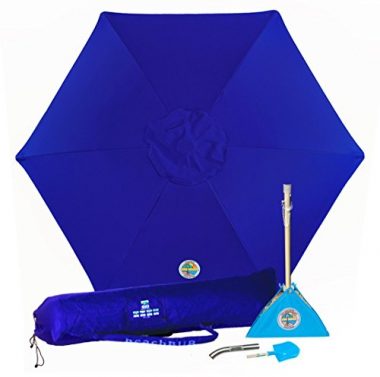
- What Makes This Beach Shade Umbrella Stand Out
- Easily withstands winds up to 35mph
- Pole wings that are filled with sand to add weight
- Shovel and sand gopher make setup easier
- Comes in a bag with a shoulder strap
- Generous 3-year warranty on the frame
Diameter: 7.5 feet
Fabric: 220g PA-coated fabric
Frame: Aluminum, fiberglass
Weight: 9 pounds
UPF: 50+
EDITORS CHOICE
Tommy Bahama Sand Anchor Beach Umbrella
- What Makes This Beach Shade Umbrella Stand Out
- Telescoping pole for easy height adjustment
- Tilting canopy for finding the perfect shade
- Sand anchor bottom makes the umbrella secure
- Aluminum undercoating improves UV protection
- Vented canopy easily resists gusts of wind
Diameter: 7 feet
Fabric: Polyester
Frame: Aluminum
Weight: 4.2 pounds
UV Protection: Yes
BEST VALUE
Sport-Brella Portable Beach Umbrella

- What Makes This Beach Shade Umbrella Stand Out
- Umbrella tent design creates much better coverage
- Relief vents prevent it from getting blown away
- Ground stakes with tie-down cords for additional security
- High-quality 210D fabric with exceptional sun protection
- Side windows with roll flaps allow some light to get inside
Diameter: 8 feet
Fabric: Polyester
Frame: Steel
Weight: 8.82 pounds
UPF: 50+
Ammsun Outdoor Beach Umbrella
- What Makes This Beach Shade Umbrella Stand Out
- Silver UV coating gives exceptional protection
- Push-button tilt canopy for adjusting the shade
- Lightweight but incredibly tough fiberglass ribs
- Vented top allows airflow and improves stability
- Telescoping steel post with easily-adjustable height
Diameter: 6.5 feet
Fabric: Silver-coating polyester
Frame: Steel, fiberglass
Weight: 4.85 pounds
UPF: 50+
Frankford Umbrellas Beach Umbrella
- What Makes This Beach Shade Umbrella Stand Out
- Marine-grade acrylic fabric with exceptional durability
- Completely resistant to mold and mildew
- Smooth Ash wood post with strong aluminum joints
- Flexible ribs won’t get damaged by the wind
- Heavy-duty carry bag included with the purchase
Diameter: 7.5 feet
Fabric: Marine-grade acrylic
Frame: Aluminum/Ash Wood, fiberglass
Weight: 14 pounds
UV Protection: Yes
Impact Canopy Beach Umbrella
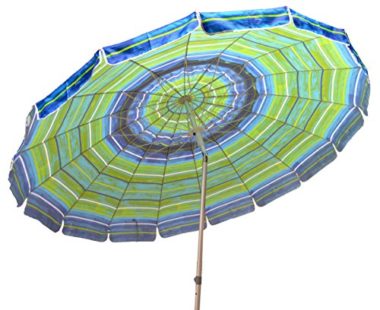
- What Makes This Beach Shade Umbrella Stand Out
- Strong sand anchor makes planting easier
- Lightweight and portable (carry bag provided)
- Sixteen ribs give excellent canopy support
- Teflon coating makes it rain-resistant too
- Push-button locking mechanism for easy opening and closing
Diameter: 8 feet
Fabric: Teflon-coated spun polyester
Frame: Aluminum, fiberglass
Weight: 9 pounds
UPF: 50+
Wondershade Ultimate Beach Umbrella
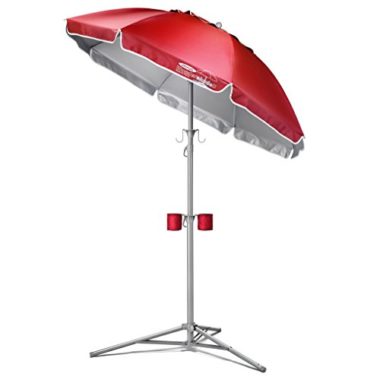
- What Makes This Beach Shade Umbrella Stand Out
- Wide tripod base guarantees stability on any surface
- Height adjusts anywhere between 3 and 8 feet
- Quick and easy to set up (10 to 15 seconds)
- Tilting canopy for better shade positioning
- Equipped with drink holders and towel hooks
Diameter: 5 feet
Fabric: Polyester
Frame: Aluminum, fiberglass
Weight: 9.4 pounds
UPF: 50+
Ammsun Heavy Duty Beach Umbrella
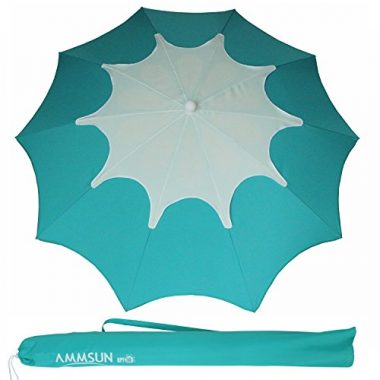
- What Makes This Beach Shade Umbrella Stand Out
- Beautiful flower umbrella beach design catches the eye
- Air-vented canopy for improved wind resistance
- Telescoping post allows making height adjustments
- Ten steel ribs make the canopy extra-strong
- Heavy-duty carry bag included in the package
Diameter: 7 feet
Fabric: Polyester
Frame: Steel
Weight: 6 pounds
UPF: 100+
EasyGo High Wind-Resistant Beach Umbrella
- What Makes This Beach Shade Umbrella Stand Out
- Heavy-duty screw bottom makes setup much easier
- Silver UV coating further improves UV protection
- Sixteen fiberglass ribs make the canopy resistant to wind
- Thick-walled anodized aluminum pole for exceptional strength
- Locking pin system with three holes for height adjustment
Diameter: 8 feet
Fabric: UV-coated Polyester
Frame: Anodized aluminum
Weight: 4 pounds
UPF: 50+
AosKe Portable Sun Shade Beach Umbrella
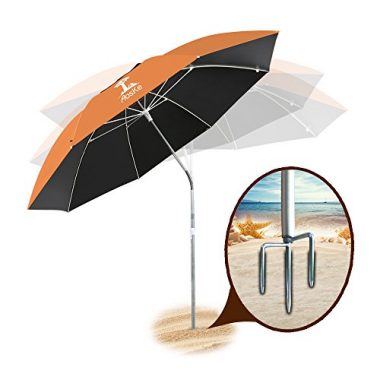
- What Makes This Beach Shade Umbrella Stand Out
- Three-point prong tip makes anchoring easy
- Aluminum and carbon fiber combo for reduced weight
- Vinyl layer blocks heat to keep you cool
- 360-degree canopy rotation (great shade adjustment)
- Bright orange color stands out on the beach
Diameter: 6 feet
Fabric: Polyester/Vinyl
Frame: Aluminum, carbon fiber
Weight: 4 pounds
UPF: 50+
How To Choose A Beach Umbrella – Buying Guide
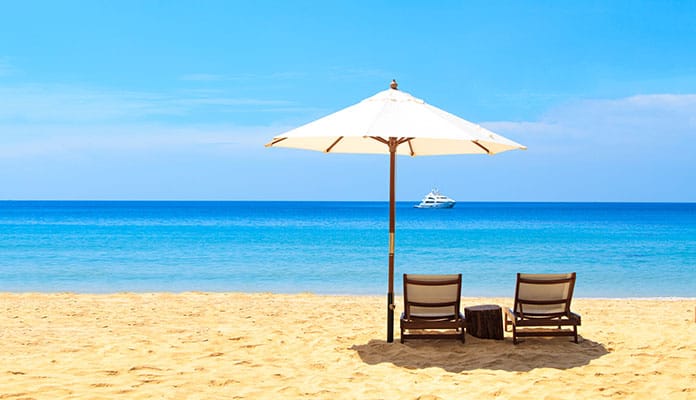
Weatherproof Design
To ensure durability, the beach umbrella you choose needs to be resistant to the weather conditions on the beach. This includes three aspects – resistance to wind, sun, and saltwater damage.
The wind is a known enemy of any type of umbrella because it can easily bend or break the ribs and make it useless. For this reason, always check the windproof rating and make sure the beach umbrella you get can easily withstand at least average wind speed.
Sun exposure will wear down any material over time. However, some are much better than others in this regard. Canopy materials should be strong and ideally have a protective coating that will slow down the deterioration.
Saltwater is perhaps the biggest enemy of the frame – if it’s not protected, it will start to rust. The best option here is to look for powder-coated steel, as it shows the best rust-resistance in beach conditions. As a bonus, it’s highly resistant to physical damage too (bumps and dings).
UPF Rating and Protection
Sun protection is the most important task of your umbrella, so you should pay close attention to the UPF when buying. This stands for Ultraviolet Protection Factor and shows you how good the material is at filtering out the harmful UV rays.
The best beach shade umbrellas should have UPF 50+ protection, which means that they block more than 98% of UV rays. This ensures that your skin is protected and doesn’t get sunburned even during the peak hours of the day.
Portability and Ease of Use
Since you’ll be hauling it to and from the beach, the umbrella you choose should be easy to pack and carry. This means that it isn’t heavy or bulky, so you don’t have any problems bringing it with you.
Regarding this, it’s important to look at weight, size, and whether it uses a telescoping design. Steel-framed umbrellas tend to be a bit heavier but provide greater strength and durability.
Also, it’s very convenient if the beach umbrella comes in several pieces because both carrying and packing are going to be easier.
FAQs
Q: How Do I Know How Big The Carrying Case Will Be?
Umbrella case size will be directly related to the pole size and whether it breaks down. If you get a telescoping pole or a model that comes in two or three pieces, the case will be much smaller and easier to carry.
Luckily, most manufacturers allow you to pack the pole, meaning that the case will be roughly the same length as the canopy radius (so the folded canopy can fit).
Q: Does The Umbrella Come With Anchors Or Will I Have To Purchase Them Separately?
It depends on the model you purchase – some have their own sand anchor, while others don’t. We recommend that you get a beacg umbrella with a base or anchoring system, as this will save you a lot of hassle. This way, you won’t need to think of ways to keep the umbrella from getting blown away.
Q: Can My Beach Umbrella Double As A Patio Umbrella?
While most beach umbrellas can double as patio umbrellas, this largely depends on the model you get. Patio umbrellas use weighted bases or tables with holes to keep them in place so, to do a good job, a beach umbrella must fit in the base well.
Also, a beach umbrella generally has a smaller canopy diameter than a patio umbrella, which can be a problem if you need to shade a dining table with several chairs. Lastly, beach umbrellas are often more brightly colored, so they may not blend well in the patio décor.
Related Reviews: Patio Umbrella & UmbrellaQ: How Do I Clean A Beach Umbrella?
If you take good care of it, your beach umbrella will last for a long time. Because it’s exposed to sand and saltwater, it’s best to clean the umbrella after every use. Here’s what you should do:
- Shake off the extra sand that got stuck to the surface (easier to do when the umbrella is dry)
- If the sand is stubborn and stuck, you can use a soft-bristled brush to get it off
- Using a cloth and clean water, wipe off the umbrella to remove salt residue from the surface
- If the canopy needs scrubbing, you can mix up some laundry detergent with water, scrub it and rinse
- Leave in the air to dry completely before storing it, so it doesn’t get moldy inside the case.
Q: How To Set Up A Beach Umbrella?
You keep it from blowing away by putting enough weight on in. This can be the weight of the sand (as described previously) or, even better, a proper base filled with either water or sand. To further improve wind-resistance, you can put your coolers and bags against the pole and add a bit more weight.
Q: Do Beach Umbrellas Block Uv Rays?
Yes, all beach umbrellas block UV rays. However, the performance varies greatly from one model to the next, so you should pay attention to the UPF rating. Lower-quality models only have 15-20 UPF, while the best beach umbrellas have UPF 50+ that will give you complete protection against sunburns.
Globo Surf Overview
For proper protection from the sun, a good beach umbrella needs to be among the things you’re bringing with you. The excellent beach umbrella will not only block out UV rays, but it will also be tough enough to resist wind. We hope that our guide and reviews have made your choice a bit easier, so you’ll have reliable sun protection that will allow you to enjoy the beach even more.
More Beach Reviews:
- Aloe Vera Gel
- Beach Bag
- Beach Blanket
- Beach Games
- Beach Ball
- Tanning Oil
- Board Shorts
- Beach Toys
- Beach Cooler
- Beach Bag Essentials
More Umbrellas Reviews:
- Travel Umbrella
- Golf Umbrella
- Pool Umbrellas


